
Viral hepatitis is a major global health threat with an estimated 257 million people living with chronic hepatitis B and 71 million people living with chronic hepatitis C worldwide. World Hepatitis Day is observed annually on July 28, the birthday of Dr. Baruch Blumberg (1925-2011). Dr. Blumberg discovered the hepatitis B virus in 1967 and two years later developed the first hepatitis B vaccine and for these achievements won the Nobel Prize.
World Hepatitis Day is one of eight official disease-specific world health days designated by the World Health Organization. The annual observance focuses attention on the huge impact of viral hepatitis infection globally – with nearly 330 million people worldwide living with either chronic hepatitis B or C.
Organizations around the world and across the United States use World Hepatitis Day to raise awareness of the problem and what needs to be done to strengthen efforts in prevention, screening and control of viral hepatitis.
Ways to Participate in World Hepatitis Day
Assess Your Risk and Take Action
Use these easy online tools to find out if you are at risk for hepatitis B or hepatitis C, then take action to locate a nearby provider of hepatitis B vaccination or hepatitis B or C testing. Share these tools with friends, family, colleagues, members, clients, constituents, and others.
Use the World Hepatitis Day Logo & Other Digital Tools
Incorporate the World Hepatitis Day logo into your website, blog posts, social media, email, and other communications. Visit the World Health Organization page and this World Hepatitis Alliance to find an array of digital tools including buttons, badges, and banners in different shapes and sizes that are ready to download and use online.
Get Social
Join the conversation on social media. Use the hashtags #WorldHepatitisDay, #HepAware, and #hepatitis to share information on viral hepatitis, local, national, and global events, and World Hepatitis Day.
Follow @HHS_ViralHep on Twitter to learn about the Viral Hepatitis Action Plan, federal hepatitis actions and resources.
Follow @cdchep on Twitter to receive information from CDC about hepatitis resources, tools, publications, campaign updates, and events.
Support the 2018 World Hepatitis Alliance's Thunderclap by clicking here.
Use CDC’s Educational Campaign Materials
Know More Hepatitis is an educational campaign aiming to increase testing for Hepatitis C among people born during 1945-1965. Supporting fact sheets, posters, infographic, buttons & badges, live-read radio scripts, templates, and other images can all be found under campaign materials.
Know Hepatitis B is an educational campaign aiming to increase testing for Hepatitis B among Asian Americans and Pacific Islanders (AAPIs). This multilingual campaign has materials in English, Chinese, Korean, and Vietnamese with select fact sheets also available in Burmese, Hmong, Khmer, and Lao. Supporting videos, fact sheets, posters, infographics, customizable flyers, and other materials can all be found under campaign materials.
CDC has multiple viral hepatitis posters available for ordering at no cost. Some posters are available in Chinese, Korean, and Vietnamese.
Watch and Share Videos
Learn more about viral hepatitis in these videos from federal partners.
Join in Supporting the Viral Hepatitis National Strategic Plan
Learn more about The Viral Hepatitis National Strategic Plan: A Roadmap to Elimination 2021-2025 that provides a framework to control the viral hepatitis epidemics and eliminate viral hepatitis as a public health threat in the United States by 2030. The Viral Hepatitis Plan features many opportunities for nonfederal stakeholders to take action in support of reaching its goals.
To help community efforts to build and strengthen viral hepatitis activities, we developed the Partner Planning Guide. The Guide can help organizations, coalitions, and others assess local needs, strengths, and existing activities, and plan new actions that align with the Viral Hepatitis National Strategic Plan.

